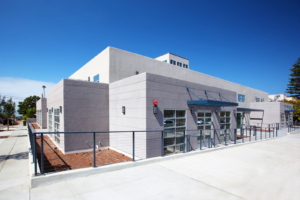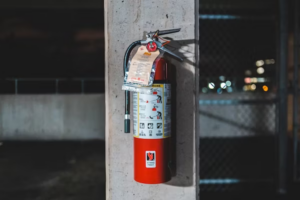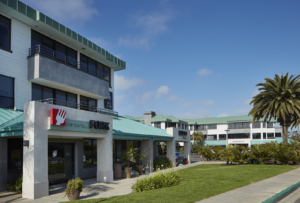Stucco offers an attractive, durable, and versatile exterior finishing solution when renovating or revitalizing commercial buildings. Upgrading aged, worn siding with modern stucco cladding can transform the aesthetics of offices, retail stores, hotels, apartment complexes, and other structures. Beyond the visual impact, stucco siding provides important functional benefits related to weather resistance, fire safety, and energy efficiency.
If your commercial building needs a facelift, here’s an overview of how stucco can enhance the property:
Aesthetic Appeal
Stucco introduces unique aesthetic options, from traditional textures like sand finish to sleek, smooth contemporary finishes. It provides a canvas for virtually any color, opening up creative possibilities. For example, neutral earth tones can establish a refined look, while bold, dynamic hues make a vibrant statement. Metallic and stone-like stucco finishes are designer options for modern buildings.
Unlike vinyl, wood, or metal siding, stucco has a seamless, monolithic appearance when applied over insulation or foam backing. This creates a streamlined, upscale look. Decorative details often seen in commercial architecture, like reveals, quoins, and arches, are easily incorporated with stucco.
Curb appeal is crucial for retail stores, restaurants, and other customer-facing businesses. Stucco cladding provides an attractive exterior that enhances visibility and draws visitors in. For office buildings and apartments, stucco siding improves aesthetics to demand higher rents and satisfy discerning tenants.
Durability
Commercial structures endure significant wear and tear from weather, foot traffic, maintenance, and daily operations. Stucco is inherently durable, designed to withstand intense use, and last for decades with minimal upkeep. Made from sand, Portland cement, and water, stucco is as hard as concrete once fully cured.
Unlike wood or engineered siding that can warp, swell, and degrade quickly in commercial settings, stucco maintains its integrity and appearance over the long haul. It won’t rot, dent, or succumb to insects and pests. Properly mixed and applied stucco won’t chip, crack, or peel.
Low Maintenance
Repainting and repairing worn commercial building exteriors can become a costly chore. Exposed wood inevitably splits, cracks, and weather, demanding frequent upkeep. Vinyl and metal sidings accumulate grime and oxidation.
Stucco siding has been virtually maintenance-free for decades, aside from occasional cleaning. It never needs paint or stain for protection. Skilled professionals can easily patch damaged areas. Repairs are simple with stucco compared to replacing whole sheets or boards of other sidings.
Fire Safety
Stucco is non-combustible and fire-resistant, earning Class A commercial fire safety ratings. Buildings sided in stucco don’t provide fuel to spread or accelerate fires. Concrete-based stucco won’t ignite from stray embers or other exposures during a fire. This added protection provides peace of mind for commercial properties.
Energy Efficiency
Applying stucco cladding over rigid insulation boosts a building’s R-value significantly. This added thermal barrier reduces heat transfer through walls. Tight construction with fewer seams and stucco’s air-tightness further improve energy performance.
According to the U.S. Department of Energy, a typical frame wall with R5 to R6 insulation alone has a rating of just R-11 to R-19 when upgraded with stucco over foam. The resulting energy savings on HVAC and utilities can be substantial for large commercial facilities.
Noise Reduction
The mass and density of stucco walls block exterior noise far better than thin vinyl or metal sidings. This enhances interiors by reducing sound transmission from nearby roads, machinery, aircraft, equipment, and other ambient noise sources common around commercial buildings. Stucco’s noise dampening properties ensure privacy and improve occupant comfort.
Cost Effectiveness
Stucco cladding provides excellent value and quick return on investment compared to other commercial siding options. The upfront installation cost is offset by decades of near zero maintenance, energy savings, and enhanced property value. Stucco siding adds instant curb appeal and can extend a building’s service life at a relatively low cost compared to major overhauls.
Environmental Benefits
Stucco that is properly specified contains local, natural ingredients and is recyclable at the end of life. It’s considered a green building material with low ecological impact. Unlike vinyl, stucco doesn’t require fossil fuel-intensive manufacturing or releases harmful chemicals. Properly installed stucco won’t substantially contribute to landfill waste. It’s a sustainable choice for eco-conscious businesses.
Hiring Commercial Stucco Contractors
Professional stucco contractors have extensive experience transforming commercial structures. They determine optimal stucco specifications and finishes to suit your building size, design, and region. Leading contractors assess façade conditions, provide accurate project scoping, and follow best practices for substrate preparation, crack isolation, drainage, accessories, curing, and quality control.
Look for commercial stucco applicators that are properly licensed, bonded, insured, and reputable. Prioritize companies with specialized equipment to reach tall buildings and experience adhering to commercial codes. Be sure to inspect current and past projects to evaluate their workmanship. You can expect a smooth installation and top-quality outcome with the right commercial stucco contractor.
Revive Your Property with Stucco
If your dated commercial building needs new life, stucco cladding can completely transform the exterior aesthetic while boosting durability, safety, efficiency, and investment value. With endless finish options, low maintenance needs, sound engineering, and modern style, stucco is ideal for contemporary commercial structures and restoring vintage charm to older properties. Contact leading commercial stucco contractors today to discuss revamping your building.
Conclusion
Revitalizing tired, worn commercial buildings with stucco cladding delivers transformative solutions. The endless design versatility, durability, and performance benefits make stucco an optimal choice for contemporary exterior facelifts. Stucco introduces attractive new aesthetics, requires minimal upkeep, enhances safety and efficiency, and adds value to commercial properties ranging from offices and retail stores to hotels, warehouses, and apartments. The modern material integrates seamlessly with existing architecture while improving function and sustainability. By engaging experienced commercial stucco contractors for proper installation, commercial owners can expect excellent ROI and renewed curb appeal, image, and pride from a stunning stucco exterior.
FAQs
Q: How long does commercial stucco siding last?
A: Correctly mixed and applied stucco lasts 50 years or more. It will outlive most other commercial building materials.
Q: Does stucco add any fire protection?
A: Stucco is non-combustible and achieves Class A commercial fire ratings for added safety.
Q: Is stucco maintenance-free?
A: Besides occasional cleaning, properly installed stucco requires virtually zero maintenance for decades.
Q: Does stucco improve energy efficiency?
A: Stucco over rigid insulation boosts wall R-values significantly to reduce heat transfer and lower energy costs.
Q: How long does a stucco installation take?
A: Depending on building size and scope, commercial stucco cladding can usually be completed in 4-8 weeks.
Q: Does stucco add value to commercial buildings?
A: Stucco siding enhances aesthetics and functionality to increase property value, demand higher rents and rates, etc.
Q: How do you repair damaged stucco?
A: Minor cracks and chips can be patched by stucco professionals. More extensive damage may require patches or full resurfacing.
Q: Can you match existing building colors with stucco during building renovation?
A: Stucco can be tinted or painted to match any color scheme, making it a versatile option for building renovation projects. Specialty finishes can also mimic stone, metal, and other materials, providing flexibility in design choices.




